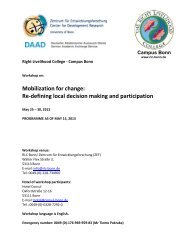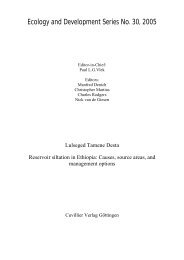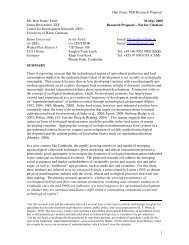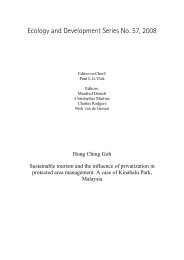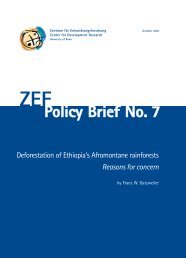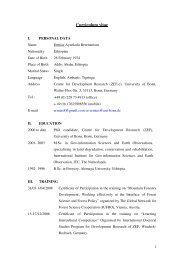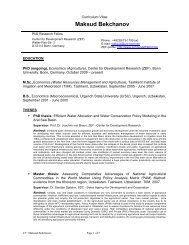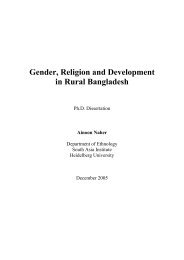Karuna Trust, Karnataka - ZEF
Karuna Trust, Karnataka - ZEF
Karuna Trust, Karnataka - ZEF
Create successful ePaper yourself
Turn your PDF publications into a flip-book with our unique Google optimized e-Paper software.
Good and Bad Practices in Microinsurance<strong>Karuna</strong> <strong>Trust</strong>, India4.5 Premium CollectionCollection ProcessesPremium collection is carried out side-by-side with enrolment. As <strong>Karuna</strong> <strong>Trust</strong> recognizedthat convincing clients takes time, it decided to switch from an annual campaign to a numberof subscription batches through the year. In 2005, enrolment continued for six months and theclients were registered with NIC in four batches. NIC’s district office was not entirely happywith this procedure, but finally accepted it. <strong>Karuna</strong> <strong>Trust</strong> now needs to indicate the number ofthe subscription batch number when transmitting claim documents. <strong>Karuna</strong> <strong>Trust</strong> considersswitching back to annual subscription in 2006 with a subscription period in October-December when potential clients have most income. During premium collection in July 2005,it turned out that many daily labourers were unable to find employment and thereforeadvocated for changing the time of premium collection.<strong>Karuna</strong> <strong>Trust</strong> mainly uses its social workers, but also relies on field offices to collect thepremiums. The social workers at Gram Panchayat level attend most of the meetings of theself-help groups. The SHGs are the institutionalised contact point between <strong>Karuna</strong> <strong>Trust</strong> andmany potential clients and therefore play an important role in the subscription and collectionprocess. Some groups organise regular savings to pay for premiums and hand this amountover to <strong>Karuna</strong>’s staff; others collect the full amount in one month.Additionally, social workers visit households not participating in the SHGs. If thesehouseholds or SHG members cannot pay, social workers visit them a second time. Theprogramme coordinators also attend community meetings and visit households to collectpremiums. Many clients directly address the social workers in the health facilities or visit<strong>Karuna</strong>’s field office.The premium collected is accumulated at the field office and deposited to a bank accountevery few days. When the enrolment period is over, the money is transferred to NIC alongwith the list of the members.Problems (and Solutions)Since many people handle many small amounts (accumulating to bigger ones), fraud andmisuse can be expected. Some of the social workers did not directly forward the money to<strong>Karuna</strong> <strong>Trust</strong>’s office, but paid some of their own bills first. <strong>Karuna</strong>’s administrative staffdetected the problem by cross-checking the receipts issued (numbered consecutively) withthe amount submitted. After strict intervention from the project coordinator, the open amountof approximately $1,000 was repaid by the respective individuals.Since the scheme was initially designed with fully subsidized premiums for most members,little attention was paid to the process of premium collection. After the end of the pilot phase,there were no longer any subsidies and all members had to pay the full premium amount.Premiums were collected in June and July. Although there are some harvesting activitiesthen, there was little employment for most daily labourers as machines were used in thisharvest. Many households faced severe difficulties in paying the premium since some hadbarely enough money for food. SHG members used their health loan fund to pay for the31



